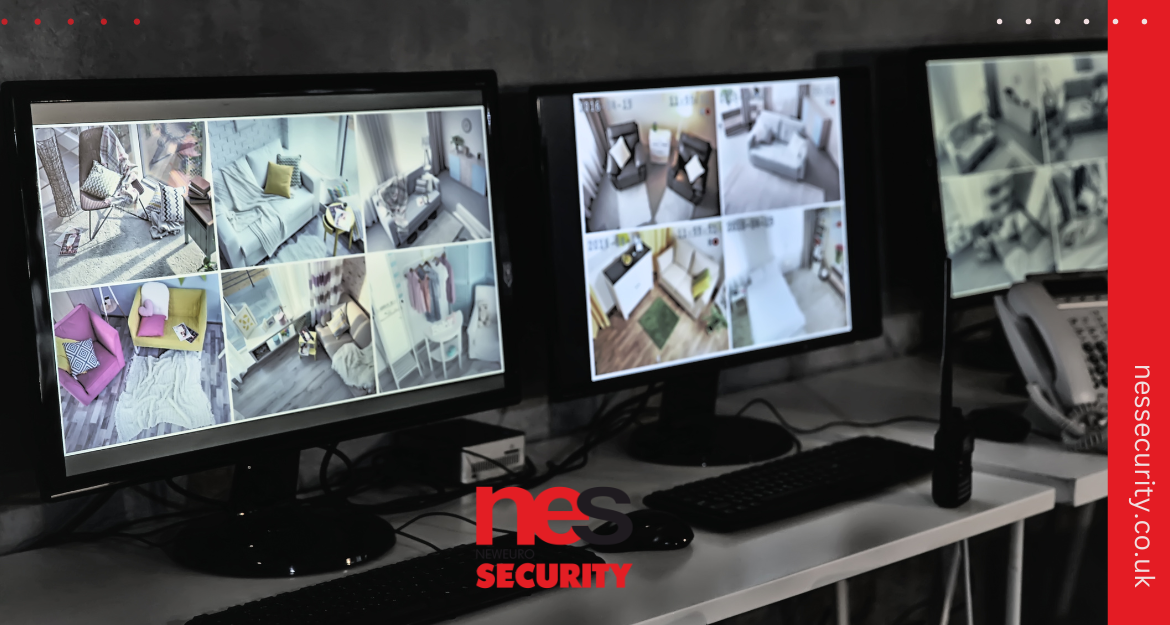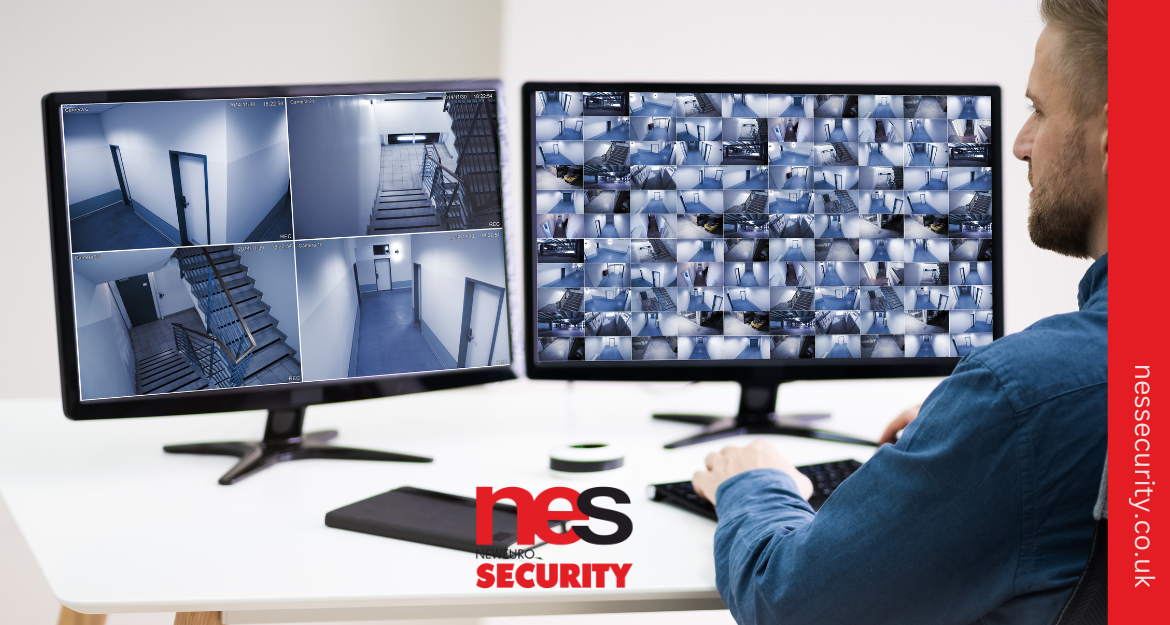In today’s technologically advanced world, surveillance plays a vital role in ensuring the safety and security of our homes, businesses, and public spaces. One key component of a surveillance system is the CCTV monitor, which allows us to visualise and monitor the captured footage in real-time. In this comprehensive guide, we will explore the world of CCTV monitors, their types, key considerations for choosing the right one, installation and setup tips, specialised features and functions, maintenance and troubleshooting, and future trends in CCTV monitoring technology. If you’re looking for expert guidance and recommendations for the best CCTV monitor for your specific needs, NES Security is here to help.
CCTV Monitors: Visualising Surveillance in Real Time
Understanding the Role of CCTV Monitors in Surveillance Systems:
CCTV monitors serve as the primary interface between the surveillance system and the security personnel. They provide a real-time display of the captured footage from CCTV cameras, allowing for immediate monitoring, analysis, and response to potential security threats. The quality and performance of the CCTV monitor play a crucial role in ensuring a clear and accurate visualisation of the surveillance footage.
Importance of High-Quality Monitors for Clear and Accurate Display:
The quality of the CCTV monitor directly impacts the clarity, sharpness, and colour accuracy of the displayed footage. High-quality monitors with features such as high resolution, wide viewing angles, and excellent colour reproduction enhance the overall effectiveness of surveillance operations. NES Security understands the significance of choosing a high-quality monitor and can recommend the best options that fit your specific needs.

Types of CCTV Monitors
Analog CCTV Monitors: Traditional Display Solutions:
Analog CCTV monitors have been widely used in traditional surveillance systems. They are compatible with analog cameras and display the captured footage in standard definition. While analog monitors are still in use, advancements in digital technology have led to the emergence of more advanced and feature-rich options.
Digital CCTV Monitors: Embracing the Advancements in Technology:
Digital CCTV monitors have revolutionised the surveillance industry with their superior display capabilities and compatibility with digital cameras. They offer higher resolutions, better image quality, and a wider range of features compared to analog monitors. Digital monitors can handle high-definition (HD) and even ultra-high-definition (UHD) resolutions, providing crisp and detailed visuals.
LCD and LED Monitors: Enhanced Clarity and Energy Efficiency:
LCD (Liquid Crystal Display) and LED (Light-Emitting Diode) monitors have become the preferred choices for CCTV surveillance due to their exceptional image quality, energy efficiency, and slim form factor. LCD monitors use liquid crystals to modulate light, while LED monitors utilise light-emitting diodes as their light source. These technologies ensure vibrant colours, high contrast ratios, and reduced power consumption.
Key Considerations for Choosing a CCTV Monitor
Display Size and Aspect Ratio for Optimal Viewing Experience:
The size of the CCTV monitor should be selected based on the viewing distance and the area to be monitored. Larger screens are suitable for monitoring large areas, while smaller screens may be sufficient for smaller spaces. Additionally, considering the aspect ratio is crucial to ensuring proper scaling and distortion-free display of the surveillance footage.
Resolution and Image Quality: Ensuring Clear and Detailed Display:
The resolution of the CCTV monitor determines the level of detail and sharpness in the displayed footage. Higher resolutions, such as Full HD (1080p) or 4K UHD, provide clearer and more precise visuals. NES Security can guide you in choosing the right resolution based on your specific surveillance requirements.
Connectivity Options and Compatibility with CCTV Systems:
It’s essential to ensure that the CCTV monitor is compatible with the surveillance system’s connectivity options. Common connectivity options include VGA, HDMI, and BNC (Bayonet Neill-Concelman), which allow seamless integration with cameras and other surveillance equipment. NES Security can help you select a monitor that matches the connectivity requirements of your CCTV system.
Ergonomics and Adjustability for Comfortable Monitoring:
Considering the ergonomics of the CCTV monitor is vital, especially for 24/7 surveillance operations. Features such as tilt, swivel, and height adjustment enable optimal positioning for comfortable viewing. Additionally, the monitor’s anti-glare properties and flicker-free technology contribute to reduced eye strain during prolonged monitoring sessions.
Installing and Setting Up CCTV Monitors
Proper Placement and Positioning of Monitors for Maximum Visibility:
The strategic placement of CCTV monitors ensures optimal visibility of the surveillance footage. Monitors should be positioned at eye level and located in areas that provide unobstructed views. NES Security’s experts can assess your space and recommend the ideal placement locations for the monitors to maximise surveillance effectiveness.
Adjusting Display Settings and Configurations:
Once the CCTV monitor is installed, it’s essential to configure its settings for optimal display performance. Adjusting settings such as brightness, contrast, and colour calibration can significantly improve the clarity and accuracy of the displayed footage. NES Security’s professionals can assist in fine-tuning the display settings to suit your specific environment.
Integrating Multiple Monitors for Expanded Viewing Areas:
In large surveillance setups, integrating multiple CCTV monitors allows for a broader field of view and improved situational awareness. With the help of video splitters, matrix switchers, or video management software, multiple monitors can display different camera feeds simultaneously. NES Security can guide you in setting up a multi-monitor configuration tailored to your surveillance requirements.
Specialised CCTV Monitor Features and Functions
Built-in Audio and Speaker Systems for Enhanced Surveillance:
Some CCTV monitors come equipped with built-in audio capabilities, including speakers and audio input/output ports. These features enable audio monitoring and two-way communication, allowing security personnel to both see and hear the surveillance environment. NES Security can recommend monitors with enhanced audio features for comprehensive surveillance.
Picture-in-Picture (PiP) and Split-Screen Display Options:
Certain CCTV monitors offer advanced display options such as Picture-in-Picture (PiP) and split-screen functionality. PiP allows the simultaneous display of multiple cameras feeds in a smaller window, while split-screen divides the screen into multiple sections, each showing a different camera feed. These features enhance monitoring efficiency and situational awareness.

Touchscreen Monitors for Intuitive Control and Interaction:
Touchscreen CCTV monitors provide an intuitive and user-friendly interface for interacting with surveillance systems. With touch-enabled controls, security personnel can navigate menus, control camera movements, and access various features directly on the screen. NES Security can recommend touchscreen monitors that streamline the monitoring process.
CCTV Monitor Maintenance and Troubleshooting
Cleaning and Care for Long-Term Performance:
Regular cleaning and maintenance of CCTV monitors are essential to ensuring optimal performance and longevity. Dust, fingerprints, and smudges can affect the clarity of the displayed footage. Proper cleaning techniques, using non-abrasive materials and approved cleaning solutions, can help maintain the monitor’s visual quality.
Troubleshooting Common Monitor Issues:
CCTV monitors, like any electronic device, may encounter occasional issues. Common problems include flickering screens, signal loss, or colour distortion. Troubleshooting techniques, such as checking cable connections, updating drivers, or adjusting display settings, can resolve many common monitor issues. NES Security’s experts can provide guidance and support in troubleshooting monitor-related issues.
Regular Calibration and Updates for Optimal Display Quality:
Periodic calibration ensures that the CCTV monitor maintains accurate colours, brightness, and contrast levels. Calibration tools and software help adjust the monitor’s settings to meet industry standards and ensure consistent display performance. Additionally, staying up to date with firmware updates and driver upgrades ensures compatibility and access to the latest features and improvements.
Future Trends in CCTV Monitoring Technology
Advancements in Display Technology: Higher Resolutions and Refresh Rates:
As technology progresses, CCTV monitors continue to benefit from advancements in display technology. Higher resolutions, such as 8K and beyond, provide unprecedented clarity and detail in surveillance footage. Additionally, faster refresh rates contribute to smoother motion rendering, minimising motion blur, and improving overall visual quality.
Integration with Video Analytics and Intelligent Monitoring Systems:
The future of CCTV monitoring lies in the integration of video analytics and intelligent monitoring systems. By leveraging artificial intelligence (AI) and machine learning algorithms, CCTV monitors can analyse footage in real-time, detecting and alerting for specific events or anomalies. This proactive approach enhances security and reduces human error.
Wireless and Mobile Monitoring Solutions:
Wireless technology is revolutionising the way CCTV monitors are deployed and accessed. Wireless CCTV monitors eliminate the need for complex cabling infrastructure, offering greater flexibility in monitor placement. Additionally, mobile monitoring solutions enable remote access to CCTV footage via smartphones and tablets, empowering users to monitor their premises from anywhere, anytime.
Final Thoughts
CCTV monitors are a crucial component of any surveillance system, providing real-time visualisation of captured footage. By understanding the types of monitors available, key considerations for selection, installation and setup tips, specialised features and functions, and maintenance and troubleshooting best practices, you can make an informed decision when choosing a CCTV monitor for your home or business. With NES Security’s expertise and recommendations, you can ensure that you have the most suitable CCTV monitor that meets your specific surveillance needs, enhancing security and peace of mind.


